Conversation 31: Socialization among non-human primates
Greetings
Below is our article about socialization among non-human primates. For this purpose, we critically used GPT 4 and reviewed literature in PUBMED, and from that we focused on one article that we considered important. In light of the abundance of observations and research, we did not include in the review reports by well-known researchers about their lives with the great apes or studies that reported excellent immediate working memory in chimpanzees or interesting works that reveal a variety of human stigmas about the characteristics of alpha males and more.
1. Group life: Most primates live in social groups whose size can range from a few individuals to dozens and even hundreds. These groups offer protection from predators, help find food, and provide opportunities for learning and social interaction.
2. Hierarchies: Many primate groups operate under a social hierarchy, often dictated by factors such as age, sex, and physical strength. Dominant individuals usually have access to the best resources and the best mating opportunities.
3. Communication: Primates communicate using a wide variety of methods, including vocalizations, facial expressions, body postures, and physical contact. Some species also use albeit simple tools and display other forms of complex behavior.
4. Grooming: This is a common behavior among primates and serves not only a hygienic purpose but also a social purpose. Grooming can help strengthen social ties and maintain group harmony.
5. Mating and Parenting: Primates' mating systems are diverse and include monogamy, polygyny (one male, multiple females) and polyandry (one female, multiple males). In many primate species, parenting is largely the role of the mother, but in some, such as marmosets, males play a significant role, and in others, such as siamangs and gibbons, parental care is shared equally.
6. Cooperation and altruism: Primates often cooperate in tasks such as hunting or caring for young. Some primates have even been observed to exhibit altruistic behavior, such as distributing food or helping other group members in need.
7. Learning and Culture: Primates are able to learn by observing others, allowing behaviors to be passed down from generation to generation. This transfer of knowledge and behaviors can be considered a form of culture.
Each primate species has its own unique behaviors and social structures. For example, baboons live in large groups with complex hierarchies, while orangutans are mostly solitary. Chimpanzees and bonobos are known for their sophisticated social structures and behaviors, including their use of tools and displays of empathy. Gorillas live in groups led by a dominant silverback male. Lesser known species, such as lemurs and tarsiers, also have interesting social lives, but are less studied than their larger relatives.
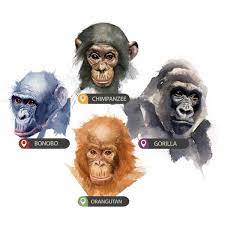
Below we will detail the social life of several types of primates including those of the "great apes".
1. Chimpanzees (Pan troglodytes): Chimpanzees live in societies characterized by fragmentation versus cohesion, where group size and composition can vary. The group usually consists of related females and their offspring, along with adult males that are not necessarily related. There is a dominance hierarchy among both males and females, with the alpha male usually being the most dominant individual in the group. It is interesting that contrary to the assumption that an alpha male is aggressive in his behavior, a detailed study shows that alpha males who win sympathy protect the weak and show a kind of empathy towards them and thus gain popularity. Chimpanzees in general are known for their complex social behaviors, including tool use, hunting in teams, and even intergroup warfare.
2. Bonobos (Pan paniscus): Bonobos also live in groups characterized by fragmentation-cohesion, but their societies are generally more peaceful and matriarchal compared to chimpanzees. Bonobos are known for their extensive use of sexual behaviors in social interactions, which are used to maintain social bonds, resolve conflicts, and express reconciliation.
3. Gorillas (Gorilla spp.): Gorillas live in groups led by a dominant silverback male who makes all the decisions, mediates conflicts, determines the group's movements, leads the others to feeding sites and takes responsibility for the safety and well-being of the others. The females take care of their offspring with the help of young females.

Orangutans (Pongo spp.): Orangutans are usually solitary, especially the males. The females are usually accompanied by their offspring. Adult males and females usually meet only to mate. Adult males are territorial and emit long calls that warn other males to stay away from their territory and attract females.
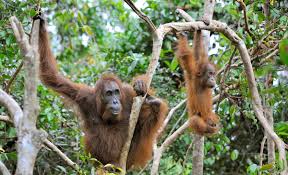
5. Baboons (Papio spp.): Baboons live in herds, which can include a few dozen individuals and how close they are there is a strict hierarchy, with dominant males getting access to the best food and mating opportunities. Male baboons also guard against predators.
6. Capuchin monkeys (Cebus spp. and Sapajus spp.): Capuchin monkeys live in groups of 10 to 35 individuals. They have a complex social structure with a clear dominance hierarchy, which is maintained through a variety of behaviors including aggression, grooming and forming alliances. Capuchin monkeys are known for their extensive use of tools.
7. Ring-tailed lemurs (Lemur catta): These lemurs live in groups of 15 to 20 individuals, and unlike many primates, their groups are often dominated by females. Group members communicate through a complex system of smells and sounds.
8. Spider monkeys (Ateles spp.): Spider monkeys live in large communities but split into smaller groups to search for food during the day. The smaller groups usually consist of mature females and their offspring, with the males roaming separately.
9. Gibbons (Family: Hylobatidae): Gibbons are monogamous and live in small, stable family groups consisting of a mated pair and their young offspring. They are territorial, using loud songs to warn others of their presence.
It is worth remembering that there is significant variation in social behavior depending on factors such as habitat, nutrition and the presence of predators.
Interestingly, many non-human primate species exhibit the ability to recognize individual faces, both within their own species and between species. Facial recognition is essential for social species because it enables social interaction, including recognizing family members, remembering previous interactions, and distinguishing friend from foe.
It should be noted that these species include:
1. Chimpanzees (Pan troglodytes): Chimpanzees have been shown to recognize the faces of other chimpanzees, even in photographs. They have also been observed to recognize human faces, indicating an ability to recognize individuals across gender lines.
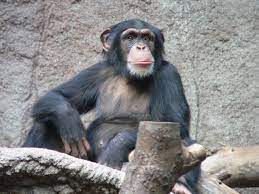
2. Bonobo (Pan paniscus): Like chimpanzees, bonobos are very close to humans and have demonstrated facial recognition abilities. This includes recognizing both bonobo and human faces.
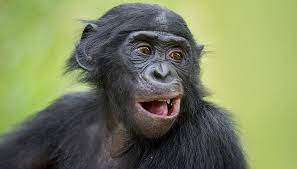
3. Macaque monkeys (Macaca spp.): Macaque monkeys have demonstrated strong facial recognition abilities. For example, research on rhesus macaques (Macaca mulatta) showed that they can recognize faces of their own kind and distinguish between familiar and unfamiliar individuals. They also show some recognition of human faces.
4. Capuchin monkeys (Cebus spp. and Sapajus spp.): Capuchin monkeys are significant social animals and have shown facial recognition abilities. They can recognize and remember faces of other capuchins.
5. Gibbons (Family: Hylobatidae): Gibbons are known to have facial recognition abilities, essential to their monogamous social structure.
6. Orangutans (Pongo spp.): Orangutans have been found to recognize faces of their own kind. They also show recognition of human handlers, indicating cross-species recognition ability.
Facial recognition of conspecifics, including humans, is common in primates that have a history of close interaction with humans, such as those held in captivity. However, it is important to note that the ability to recognize faces of other species, especially humans, varies between individuals and may depend on factors such as the animal's experiences and individual cognitive abilities.
It is also worth mentioning that while many primates have demonstrated the ability to recognize faces, the exact mechanisms and cognitive processes involved may differ from those used by humans. For example, while humans typically recognize faces as a whole (a phenomenon known as "holistic processing"), some studies suggest that other primates may rely more on individual facial features.
The question arises, which parts of the brain of non-human primates are involved in face recognition?
Face recognition in nonhuman primates involves several brain regions, similar to the process in humans. Key areas include:
1. The inferotemporal cortex (IT): This is part of the visual cortex, in its ventral part, involved in object recognition, including faces. Single-cell recording studies in monkeys identified "face-selective" cells in this region.
2. The superior temporal gyrus (STS): This area processes dynamic facial cues and is involved in the perception of eye gaze, facial expressions and other movements. This area helps primates understand the intentions and emotional states of others.
3. The anterior cingulate cortex (ACC) and the orbitofrontal cortex (OFC): these areas are associated with evaluating social information from faces and making decisions based on this information.
4. Amygdala: This area of the brain processes emotional reactions and is important for associating faces with emotional reactions. The amygdala responds to faces expressing different emotional states and contributes to social cognition.
5. Fusiform Face Area (FFA): Although it is more controversial whether non-human primates have a direct equivalent to the human FFA, research suggests the existence of "face parts" in the temporal lobe, which are involved in face recognition. These areas may be similar to the FFA in humans, which is key in humans for face perception.
Each of these areas does not work in isolation. These are part of a larger network of brain regions that work together to recognize and interpret faces. Studies of face recognition in nonhuman primates have often been conducted with macaque monkeys, but it is likely that similar regions are involved in other primate species as well. However, more research is needed to fully understand the similarities and differences in face recognition between humans and other primates.
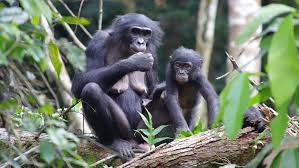
An interesting aspect regarding socialization in primates is that of social cognition in non-human primates.
Social cognition refers to mental processes that make it possible to understand and interpret the behaviors, intentions and emotions of others. This aspect is essential for social species, including non-human primates, and enables complex interactions within groups. Here are some components of social cognition in nonhuman primates:
1. Theory of mind: The theory of mind [THEORY OF MIND] is the ability to understand that others have thoughts, beliefs and perspectives different from your own. While it is a complex cognitive skill most developed in humans, there is evidence to suggest that some nonhuman primates, particularly great apes such as chimpanzees and bonobos, have a rudimentary form of theory of mind.
2. Empathy: Nonhuman primates can exhibit empathic behaviors, such as comforting distressed group members, suggesting that they can understand and share the feelings of others. For example, bonobos have been observed comforting others who have lost in battles, and chimpanzees have been observed caring for the injured or sick.
3. Facial recognition: As mentioned earlier, many non-human primates can recognize individual faces, which is essential for tracking social relationships and remembering past interactions.
4. Social learning: Nonhuman primates can learn behaviors by observing others, a process known as social learning or observational learning. This ability can lead to the development of culture, when behaviors are passed down from generation to generation.
5. Deception: Some nonhuman primates have been observed using deception to manipulate the behavior of others, which requires an understanding of others' intentions and beliefs.
6. Cooperation: Nonhuman primates often engage in cooperative behaviors, such as hunting or grooming, that require an understanding of the roles and intentions of others.
The development and expression of these social cognitive abilities depends on both genetic and environmental factors, and there is great variation between species. For example, while all nonhuman primates can engage in social learning, more complex cognitive skills such as theory of mind and deception appear to be more developed in great apes, which have closer evolutionary relationships to humans. Furthermore, social cognition in primates is not simply a result of larger brain size, but involves specialized cognitive mechanisms and brain regions, many of which are also found in humans.
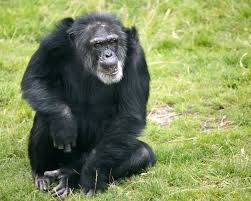
Below we will provide a translated summary {Y.L.) of researcher Kirsty's position from an article about a socio-ecological perspective on the communication of gestures of great ape species, individuals and social units. The article was published in the journal Ethology Ecology and Evolution in 2022, volume 34, number 3, 235-259.
Kirsty E. A socio-ecological perspective on the gestural communication of great ape species, individuals, and social units. Ethology Ecology & Evolution 2022, VolL. 34, no. 3, 235-259
"Over the past 30 years, most of the research on nonhuman primate gestural communication has been produced by psychologists, who shaped the questions asked and the methods used. These researchers drew on concepts from the fields of philosophy, linguistics, anthropology, and ethology, but despite these broad influences the field has forgotten To place the gestures in the socio-ecological context in which the diverse species, individuals and social units exist.
All great apes use gestures to communicate. Discrete body movements create gestures that are particularly useful in dyadic social interactions where an individual wants to communicate with their partner or another individual in a group to achieve a specific goal. Great apes use gestures to initiate grooming, request and initiate mating, ask for food, signal others to move away or come closer, invite play, and more. When considering the goals that great ape gestures achieve and the contexts in which apes make gestures, it seems clear to expect variation in gesture use at the individual, community, and species levels. However, research on gesture variation has yet to frame this debate through a socio-ecological lens. That is, the ways in which gestures change have not been fully considered in terms of the impact of social structures and environmental constraints on the individuals who use them.
Historically, the study of great ape gestures has been concerned with how gestures are acquired. The two main schools of thought can be summarized in general as "ontogenetic ritualism" and "phylogenetic ritualism" – the first is acquired, when repeated actions become rituals and gestures created from the beginnings of partial and incomplete movements, while in the second type gestures are passed on through biological inheritance, as a result of natural selection for These communication signals. In the first type, we would expect a lot of individual variation in the gesture repertoire as different actions or different parts of an action become ritualized for particular interaction partners, and in the second genetic one, we would expect very little if any variation. It is implied from both approaches that the differences in form arise from the development of personal experiences and experiences on the one hand or genetics on the other, but what about the role of the individual within his group and how his group is structured? Or how does the individual's environment physically limit the development and deployment of their communication strategy?
Importantly, neither approach fully captures the ways in which gestures can change. As in many other communication systems, from human language to birdsong, the variation in signal types and available repertoire represents only one dimension, with many others largely unexamined. Communication may vary in terms of the overall rate of signal production, as well as production rates for specific signal types, contexts, and meanings; the speed, magnitude or amplitude of whole signals or parts of signals; The types of objects used as part of the letter. And this variation may occur in response to diverse socio-ecological factors, from vegetation density and availability of objects to social relationships, reproductive status, and more. Expanding the search for variation in gestures is of course important to questions surrounding gesture ontogeny [derived from the first type] and gesture use more generally, but also contributes to broader discussions of primate culture.
In theory, any communication system must be adapted, either through evolutionary selection or learning processes or a combination of both, to the social-ecological niche in which it occurs. Among the great apes, there is significant variation in both the physical environment and the social environment of individuals, groups and species. Their habitats include dense rainforests, swamp forests and open savannah while certain generalizations can be made about the habitat of each species, for example: high variation in seasonal fruit availability for orangutans, there is of course variation between communities within each species. Unfortunately, some habitats are better studied than others. For bonobos and chimpanzees most research has been conducted in rich rainforest habitats, and this has (until recently) shaped our understanding of these species. However, there are bonobo communities that live in habitats with savanna characteristics for example, and the largest populations of West African chimpanzees inhabit savanna woodland. These landscapes are dramatically different. Integrating the physical environments of great apes into our understanding of their communication systems is essential to uncovering their full and diverse behavioral repertoire.
The effect of social ranking or gentrification.
Social communication is the key to an individual's ability to develop and maintain social relationships with other group members. For example, it has been suggested that a chimpanzee's pant gurgling reflects the intention of the caller's interaction, examines the recipient's motivation and mood, conveys respect, as well as a tool to prevent aggression. The absolute and relative social ranking of the individual has been shown to have a wide influence on the vocal communication of the monkeys. For example, chimpanzee vocalizations are produced almost exclusively by lower-ranking individuals, toward higher-ranking individuals, and higher-ranking individuals produce more trouser hoops than lower-ranking individuals and more vocalizations than other age groups in general. Higher-ranking gorillas give more mating calls than lower-ranking individuals, and in bonobos, lower-ranking females are more likely to produce mating calls when interacting with higher-ranking females during genital rubbing.
The gestures associated with rank in the hierarchy used by subordinate individuals in interactions with more dominant individuals (e.g., "wrist present" and "buttock show") appeared later in life in a group of captive chimpanzees, compared to other types of gestures. In a wild community of chimpanzees from East Africa, it was found that male rank has relatively little effect on the rate of gesture use, with the exception of an alpha male – who was very prolific in this regard. In conclusion, while great ape gestures were included in Darwin's writings in 1872, their in-depth investigation as a field of research spans only a few decades. Much of this research has come from a cognitive perspective – including the important work of establishing that this communication system is flexible and includes a deliberate sharing of goals between specific communication partners. To do this, the researchers first focused their efforts on small groups of monkeys in captivity where clear, reliable observations could be made (chimpanzees, orangutans, gorillas, bonobos). Only in the last 10 years has the field of monkey farm research returned to the wild: monkey farm research in situ.
That being said, it has become increasingly important to understand the social-ecological context in which monkeys use their gestures. Communication systems, like other behaviors, are adapted to the niche in which they are used. As a field, we are just beginning to ask the questions of how the monkey's physical and social environment affects its gestures."
Best wishes and see you in the next conversation,
Dr. Igor Salganik and Prof. Joseph Levine
 Prof. Joseph Levine, M.D. is an emeritus associate professor in the Division of Psychiatry, Faculty of Health Sciences, Ben Gurion University in Israel. Prof. Levine is a certified psychiatrist with clinical experience in controlled trials of adult psychiatric disorders and in psychotherapy. He was awarded a NRSAD independent investigator grant for the study of Creatine Monohydrate in psychiatric disorders -- mainly Schizophrenia. He resides and treats patients in Tel Aviv and all of central Israel.
Prof. Joseph Levine, M.D. is an emeritus associate professor in the Division of Psychiatry, Faculty of Health Sciences, Ben Gurion University in Israel. Prof. Levine is a certified psychiatrist with clinical experience in controlled trials of adult psychiatric disorders and in psychotherapy. He was awarded a NRSAD independent investigator grant for the study of Creatine Monohydrate in psychiatric disorders -- mainly Schizophrenia. He resides and treats patients in Tel Aviv and all of central Israel.
Leave a comment